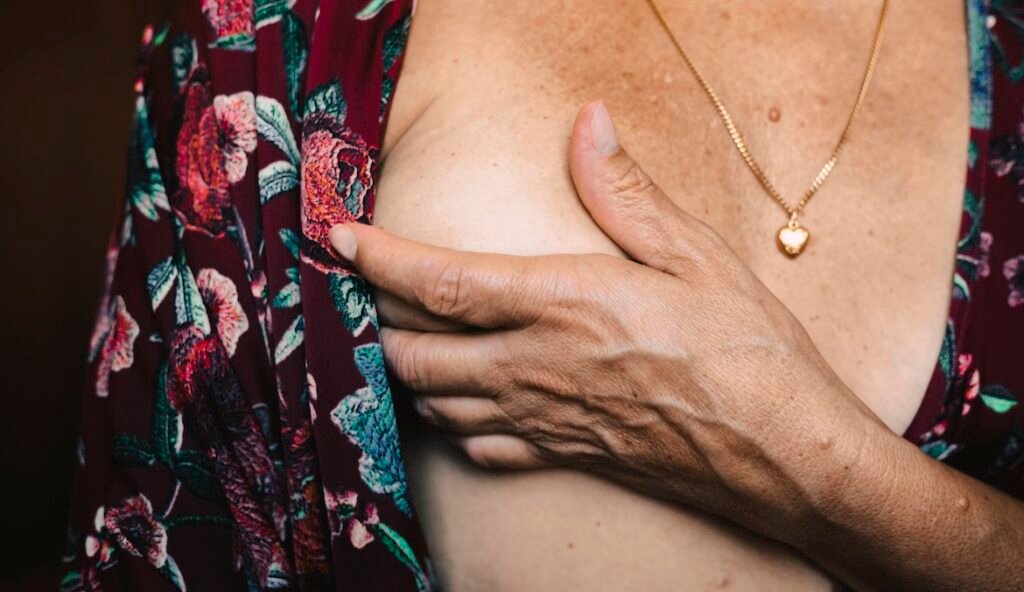oneIn the early summer of 2020, a few months into the COVID-19 pandemic, Miami Public Schools clinical art therapist Morgen Chesonis-Gonzalez felt a persistent pain in her right armpit that triggered an inner alarm bell. She knew something was wrong with her body.
Chesonis-Gonzalez, 47, has been getting annual mammograms even though she has no family history of breast cancer. She follows guidelines set by the American Cancer Society, which recommend that all women with an average risk of breast cancer start getting mammograms before age 40.
“It was still early in the pandemic in schools and everything was turned upside down and there was a lot of uncertainty,” Chesonis-Gonzalez told Well+Good. “Because I was in good health, I decided to postpone my mammogram. “At that stage of the pandemic, our message was, if you’re not an essential worker, please stay home.”
But after a month of unexplained pain and swollen and inflamed armpits, Chesonis-Gonzalez knew it was time to get a mammogram. Her fears were somewhat confirmed when doctors asked her to follow up with a mammogram via ultrasound and biopsy. On August 20, 2020, she was officially diagnosed with breast cancer. But her diagnosis had an interesting twist.
Chesonis-Gonzalez was diagnosed with not one, but two different types of breast cancer. Her armpit pain was caused by two malignant tumors in her breasts. One of them is stage 2 triple-negative breast cancer, which Chesonis-Gonzalez calls “a particularly aggressive type of breast cancer that can metastasize quickly.” The other is a type of cancer called ER+/PR+/HER2-, which is a type of cancer that grows in response to estrogen, according to the Mayo Clinic.
That Chesonis-Gonzalez had to endure it all alone made the news even more shocking. Because of COVID-19 restrictions, her husband had to wait in the parking lot, listening to the diagnosis and taking notes on the phone. Chesonis-Gonzalez’s first reaction was shock—her previous mammogram had found nothing abnormal. “I kept thinking about how this would affect my children,” she said.
It’s rare to have two cancers at the same time, especially two breast cancers. A dual diagnosis means Chesonis-Gonzalez must undergo multiple treatments in a row. Because of the pandemic, she had to go through these processes alone, always worrying that she might catch the virus.

How common (or rare) is it to be diagnosed with two breast cancers at the same time?
Chesonis-Gonzalez’s diagnosis is particularly rare. Starr Koslow Mautner, MD, a breast cancer surgeon at the Miami Cancer Institute at Baptist Health South Florida, said patients with two different types of cancer, one of which is triple negative, Cases are rare, occurring in approximately 5% of patients. Although multiple tumors Same Types of breast cancer are not rare, multiple different Dr. Mautner added that the number of ER (estrogen), PR (progesterone), and HER2 (human epidermal growth factor) receptors is different.
“Patient prognosis often depends on cancers that are larger or have more aggressive characteristics,” Dr. Mautner said. According to Dr. Mautner, if the tumors are in different quadrants of the breast, it usually means you need a mastectomy (surgery to remove the entire breast) rather than a lumpectomy (surgery to remove the entire breast). remove the tumor). This also means that treatment plans may include multiple drugs that target different individual receptors for each tumor.
In Chesonis-Gonzalez’s case, this resulted in two different treatments: chemotherapy for the triple-negative mass, and endocrine therapy for the estrogen-receptor-positive mass.
The difference between triple negative breast cancer and other types of breast cancer
Triple-negative breast cancer, written as ER-/PR-/HER2-, is considered an “aggressive breast duct cancer that lacks receptors,” Dr. Mautner said. This means, according to the American Cancer Society, that cancer cells don’t have estrogen or progesterone receptors, and they don’t produce much of the growth-promoting protein HER2.
This type of cancer can spread quickly and is often more difficult to treat. It accounts for only 10 to 15 percent of all breast cancers, and is more common in people under 40, black people, or people with a BRCA1 gene mutation, which increases your risk of breast cancer, according to the American Cancer Society Overall risk. (For context, Chesonis-Gonzalez does not have a BRCA1 mutation.)
In these cases, patients almost always need chemotherapy before or after surgery because it cannot be treated with targeted drugs, Dr. Mautner said.
Hormone-positive breast cancer is more common
Chesonis-Gonzalez’s second tumor had different characteristics—it was a smaller, Stage 1 tumor (meaning it was contained in one area) called a Luminal A tumor. Luminal A tumors (medically known as ER+/PR+/HER2-) are a “very common” type of hormone-positive breast cancer, Dr. Mautner said. This type of cancer grows slowly and is highly sensitive to endocrine therapy, which involves taking oral drugs that block estrogen receptors for at least five years.
Susan G. Komen said hormone-positive breast cancer is more common, accounting for about 70 to 80 percent of new breast cancer diagnoses.
In summary, hormone receptor-negative breast cancer (such as triple negative) responds to chemotherapy, while hormone receptor-positive breast cancer responds to endocrine (i.e., hormonal) therapy. While endocrine therapy limits the cancer’s ability to get the hormones it needs to grow, chemotherapy can kill cancer cells or slow their growth, according to the National Cancer Institute. Because Chesonis-Gonzalez suffers from both conditions, she must undergo both treatments.
Type of breast cancer affects recurrence rate
Whether someone’s breast cancer is hormone receptor positive or negative also affects recurrence. “If triple-negative breast cancer comes back, it’s likely to happen within the first two to three years after initial treatment,” Dr. Mautner said. But “recurrence after five years of triple-negative breast cancer is rare compared to estrogen-receptor-positive breast cancer.”
On the other hand, hormone receptor-positive cancers are more likely to relapse more than 10 years after diagnosis, Susan G. Komen said. Case in point: January 2023 Annals of Surgical Care and Research1, The study tracked 2,730 breast cancer patients and found that 47.8% of hormone-positive participants had a recurrence within five years of diagnosis, while 78.7% had a late recurrence (i.e., five years later).
“While the risk of recurrence is affected by tumor subtype, prognosis and survival rates are more dependent on tumor stage,” Dr. Mautner added. Thankfully, Chesonis-Gonzalez responded well to chemotherapy, which reduced her risk of recurrence. “Although she had two cancers in one breast, one of which was an aggressive triple-negative breast cancer, her prognosis was good,” Dr. Mautner said.
Treatment is a multifaceted approach
Chesonis-Gonzalez’s treatment has been particularly challenging, not only because of the pandemic but also because it’s rare to have two cancers in the same breast. “Everything changed after the diagnosis,” she said. “I was only 47 years old, and I felt like my youth had been cut short and I couldn’t see my children grow up.”
Her treatment lasted about ten months in total, beginning with four months of chemotherapy to shrink the tumor. Dr. Mautner said that in many cases like this, chemotherapy can actually reduce the cancer to the point where no tumor is found during surgery. This usually gives people an “excellent prognosis,” she said.
After Chesonis-Gonzalez completed chemotherapy, she had a bilateral mastectomy, a surgery to remove both breasts. Chesonis-Gonzalez said she chose to have both breasts removed for “peace of mind.” Dr. Mautner said the decision is a highly individual one: “In the absence of a genetic mutation, removal of a healthy breast is not medically necessary, but many women choose this option for peace of mind. ‘or symmetry.
But the treatment is far from over. After surgery, she began physical therapy to help expand the range of motion in her chest and shoulders and prepare her for the treatment that came next: 28 daily rounds of radiation therapy. During each radiation treatment, Chesonis-Gonzalez had to raise her arms above her head for long periods of time — no small feat after breast surgery. The goal is to ensure that no cancer remains.
It also takes an emotional toll
In addition to the physical toll, the treatment also took a psychological toll. This was something she never expected: Her diagnosis was rare, she had no family history of breast cancer, and she didn’t have any existing factors that might increase her risk (such as a BRCA1 mutation). Before the pandemic, she would get annual mammograms. On top of that, because of the pandemic, Chesonis-Gonzalez had to go to her appointments alone — six feet apart from everyone and wearing a double mask.
“While I felt everyone’s love and prayers, during my most vulnerable months fighting for my life, during aggressive cancer treatment, we were physically cut off from all social support,” Chesonis- Gonzalez said. “It’s had an impact on my mental health and it’s caused difficulties for my family.”
Life after both types of cancer is possible
After all the chemotherapy, surgery, therapy and radiation (even after leaving no trace of cancer in her body), Chesonis-Gonzalez still needed six months to recover. After her mastectomy, she elected to have breast reconstruction surgery, and now, more than four years after her diagnosis, she is nearing the end of her maintenance treatment.
Although dual diagnosis and intensive therapy are rare, Chesonis-Gonzalez has been able to continue working as a clinical art therapist through virtual appointments for Miami Public Schools. She also has some hobbies, such as participating in a dragon boat team called Miami SOS Team, a team dedicated to breast cancer patients (they even compete with other teams around the world). Had she not chosen to get a mammogram in 2020, her story might have been very different.
Skipping mammograms is common, especially during the pandemic. Dr. Mautner said the number of people skipping mammograms increased by 44% between 2019 and 2020, with some places not returning to pre-pandemic levels until after 2022. The consequences of people skipping mammograms.
But annual mammograms are critical to detecting breast cancer early and successfully treating the disease. If left untreated, it can spread to lymph nodes, leading to more aggressive treatments and side effects. Ask your OB-GYN about the best age to start getting mammograms (the average age for women at risk is 40, but if you’re at higher risk, it may be younger).
Of course, if you notice any pain, bruising, redness, or lumps in your armpits or breasts, contact your OB-GYN.
Well+Good articles reference scientific, reliable, up-to-date, and robust research to support the information we share. You can count on us on your health journey.
- Li, Yongzhu et al. “Prognosis based on time to breast cancer recurrence.” Annals of Surgical Care and Research Volume 104.1 (2023): 1-9. doi:10.4174/astr.2023.104.1.1

